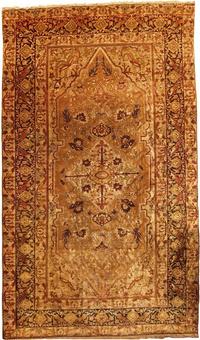Antique handmade oriental rug No. 46486 Hereke, ca. 1790 Silk Turkey 233 x 140 cm

Larger images (will open in new window)
Please click on the thumbnails below for a larger view
| main view |
 |
| Item Number: |
46486 |
| Name: |
Hereke, ca. 1790 Silk |
| Country of Origin: |
Turkey |
| Size: |
233 x 140 cm |
| Made:
|
ca. 1790 |
| Pile: |
Silk |
Foundation
(warp and weft): |
Silk |
| Design: |
floral and pictorial / little medallion |
| Ground Color: |
light brown |
| Knots per sqm: |
490,000 |
| Remarks: |
This is a unique handmade / hand-knotted / traditional oriental carpet
The pile of this carpet is made of silk
This is a museum piece. Pile not perfect. On foundation there is some damage due to the high age, repair not possible. Mihrab Design. Animal motifs (lions hunting sheep). This piece has been dyed with vegetable dyes only.
This carpet has a total of approximately 1,597,400 knots and it took skilled carpet makers about 2,130 hours or 237 working days to hand-knot this carpet. |
 add to cart
add to cart
More about the provenance Hereke, ca. 1790 | Turkey
Hereke is located in North West Turkey at the Gulf of Izmit at the Marmara Sea approx. 60 km to Istanbul. 1844 a manufactory of cloths has been established here by Sultan Abd-ul Mejid. 1890 the then Sultan Abd-ul Hamid has brought master carpet weavers from Sivas, Manisa and Goerdes and expanded the manufacture to carpet making in which high quality and very fine rugs have been made. It used to be (and still is) mostly variations of Persian, French (in the style of Louis XV and Louis XVI of Savonnerie) and elegant Turkish designs. The partly gold and silver thread, the relief structure, and the very fine silk rugs often with a metallic shine are all characteristic for Hereke rugs. The wool used for the rugs is of very high quality, almost with no exception. Old Hereke rugs achieve very high prices in today's markets. Often (but not always) they are signed by the master weaver. The quality and beauty of Hereke rugs is literally legendary.
The wool of this rug has been dyed with vegetable dyes only which became very rare in Oriental rugs. Since ca. 1850 synthetic dyes found their way into carpet production. Ever since they replaced natural vegetable dyes more and more also due to the fact that the production of vegetable dyes is very time consuming and difficult. But the "aura of genuineness" can be reached to its full extent with vegetable dyes only. Vegetable dyes are made from leaves, flowers, branches, fruits and roots. They give Oriental rugs a particularly harmonic look. In general Oriental rugs "age" better and more beautifully with vegetable dyes than with synthetic dyes plus they increase a carpet's value. Most of today's production is made with synthetic dyes which makes this rug an even more desirable piece. Unfortunately many rugs in the market are being labelled as being vegetable dyed which in many colors is simply not true which damages the reputation of the carpet industry altogether.

